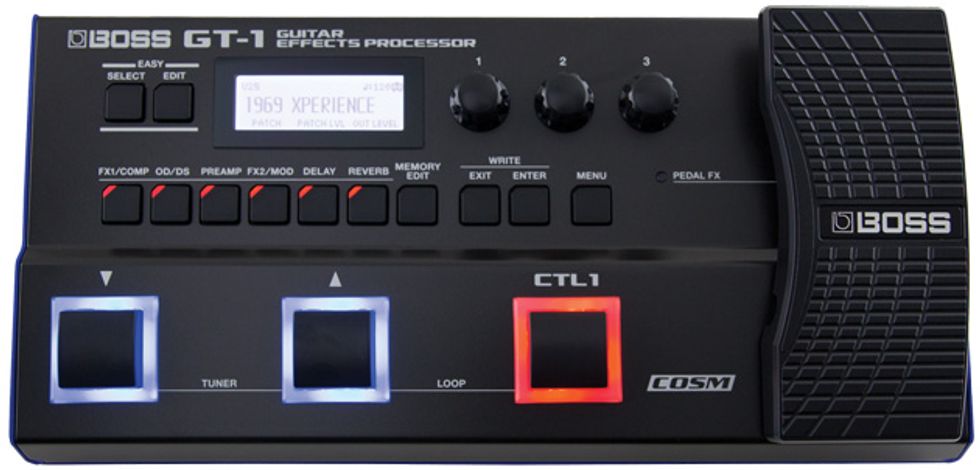While most of us happily associate Boss with an array of candy-colored stompboxes under glass at the local music shop, the company is a long-time player in the multi-effects game. Many travelling musicians swear by their platforms. And Boss makes some great ones—like the GT-100, which enables you to pop in a couple instrument cables and tap into a universe of guitar sounds and textures. The newest of Boss’ digital multi-effects units, the GT-1, is the most streamlined and compact member of the GT family. And though it’s small, it still overflows with a huge collection of authentic-sounding classic and modern tones.
Small Size, Serious Depth
It’s easy to imagine the Boss GT-1 becoming a workhorse for players that gig often and don’t sit still for long. It comes with 108 effects, an onboard tuner, a 32-second looper, an expression pedal, a secondary expression pedal input, headphone and auxiliary jacks, USB connectivity, 99 presets, 99 user-defined patches, and what seems like infinite tweakability. Plus the thing can run on batteries in a pinch or via an external adaptor. Whew!
One bit of welcome news to players that fear multi-effects units: You can figure out how to operate this one without reading through the instructions. It’s that intuitive. That said, diving deep is key to maximizing the usefulness of the unit, and the Boss Tone Studio editor/librarian simplifies that endeavor. There are also additional free presets available via download at Boss Tone Central.
At 2 pounds, 14 ounces., the GT-1 feels light but robust. And at about 12"x 6"x2 1/4", it is about the size of a schoolbook. Inevitably, there are a few trade-offs for the size. The expression pedal, for instance, is small for my big clunky feet and feels awkward if you use it sitting down. Reading the LCD readout from a standing height can be tall order, too, if you aren’t blessed with 20/20 vision.

Something for Everyone
Using a Gibson SG Classic, I plugged the GT-1 straight into a modified Fender Champ 600. Hitting the left and center footswitches together activates the tuner, illuminating a monitor on the LCD screen and the two switches as well to indicate—quite clearly—whether you’re sharp or flat. A quick scroll through the presets displays the GT-1’s vast range of plug-and-play capabilities, showcasing tones that cover old-school electric blues, modern day metal, stadium rock, and much stranger ambient and fluttering space tones. Here’s a quick sampling of some standouts. No. 77, titled “Lezly Heaven”—a tip-of-the-hat to Zeppelin’s Leslie-laden work—nails Page’s solo for “Good Times Bad Times” and, for that matter, some of John Paul Jones’ keyboard textures from “No Quarter” at more extreme pulsing settings. Preset 28, “Robins Bridge” (another heavy Leslie serving), and No. 19, “Van Flange,” will dress up your “Ain’t Talkin’ ‘Bout Love” cover with excellent and convincing marriages of drive and modulation. Presets 60, “Metal Corn,” and 61, “Dragon Metal,” demonstrate how far Boss’s modeling technology has come in replicating high-gain tones. But preset 92, “Fullertin Drive,” is a bluesy, tweed-sounding simulation that does the arguably harder job of capturing the nuances of low- to mid-gain Fender amp tones. It sounds good when you stack on the dirt, too!
Ratings
Pros:
Very convincing sounds. Nice drive tones. Vast array of features, with good presets.
Cons:
Compact size means a lot of tweaking on small LCD screen.
Tones:
Ease of Use:
Build/Design:
Value:
Street:
$199
Boss GT-1 Guitar Effects Processor
bossus.com
As with all massive preset collections, these aren’t all extraordinary. The seemingly straightforward “Mid Boost Combo” (preset 22) can sound like a muffled Twin Reverb if you’re not careful. And corrective adjustments aren’t always super easy. I managed to clear up the Mid Boost Combo preset, but I had to navigate the small LCD screen using the streamlined button function. That’s great when the preset is ideal right out of the gate. It’s less than satisfying when you have to negotiate the impressively vast array of tone tweaking options. Of course, a more accessible set of surface-mounted parameter controls would mean a less compact unit. It’s important to know that the trade-off for a compact unit is making sure your presets are tweaked to satisfaction before you take the stage.
Guitar, pickup, and amp choices remain important factors when employing the GT-1. The same factors that make single-coils or humbuckers more or less desirable for a given tone equation still apply in the GT-1. And smaller practice amplifiers can turn into a mess if you hit them with effects-heavy or high-gain presets. However, larger headroom amps like an Orange OR50 display no problems with huge delay and reverb. There’s no reason you can’t get great sounds out of the GT-1 and your existing amp no matter what its size. But as a general rule, more headroom is better.
The Verdict
Even as an old-school pedalboard devotee, I’m impressed with the sounds and convenience of the GT-1. With enough preparation you can set up the GT-1 to your exact specifications, drop it on the floor, plug it in, and get great sounds. And if you don’t feel like crafting your own tone recipes, the presets are aces. If you’re a travelling musician with the need to keep gear to a minimum, the GT-1 represents a powerful and better-than-passable alternative to big pedalboards. And considering that all these sounds and functionality come at the price of a single boutique stompbox, it’s a very impressive value.













![Rig Rundown: Russian Circles’ Mike Sullivan [2025]](https://www.premierguitar.com/media-library/youtube.jpg?id=62303631&width=1245&height=700&quality=70&coordinates=0%2C0%2C0%2C0)





